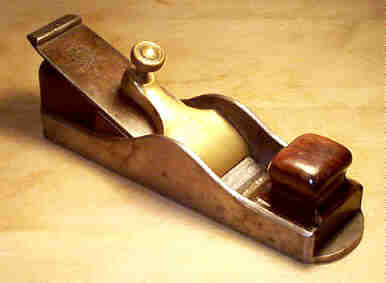

Mitre planes are among the finest metallic (any other material for that matter) planes ever produced. Their dovetailed construction, ultra-fine mouth, rosewood stuffing, and gunmetal lever cap are as much a joy to behold as the plane is to use.
The earlier mitre plane design used a wooden wedge, slipped under a bridge that spans the sides of the plane, to hold the iron in place. The later design makes use of the lever cap since it permits easier setting of the iron and because it doesn't require whacking the heel of the tool to free the wedge, which at times can be perilous with chipping or cracking a result. Because these planes require such a fine set, and a fine touch to do it, many of the planes are equipped with a snecked iron. A snecked iron is one that provides a surface (at the iron's heel) so that the iron can be tapped back a hair when the set is too deep. Snecking for the mitre plane is normally a rounded wedge-shaped piece forged onto the iron's heel. The other common form of snecking, typically found on the better shoulder planes, is a notch-like cutout along the 'tang' or neck of the iron. Some shoulder plane irons have mirror images of the snecking to give the heel of the iron a mushroom cap-like shape.
The mitre plane pictured here is one wrought by a master toolmaker in the employ of Stewart Spiers' famous and unexcelled planemaking business located in Ayr, Scotland. Spiers is generally credited as being the first fulltime manufacturer of infill planes having commenced operations ca. 1840. Other toolmaking enterprises eventually took note of his products, and jumped into the business. By the end of the 19th centrury, many of the major tool manufacturers of Sheffield, England were making planes that are practically identical to Spiers' designs. Names such as Marples, Preston, Mathieson, and the London based Norris, all made planes that represent the pinnacle of the planemaking trade.
Copyright (c) 1998-2012 by Patrick A. Leach. All Rights Reserved. No part may be reproduced by any means without the written permission from the author.